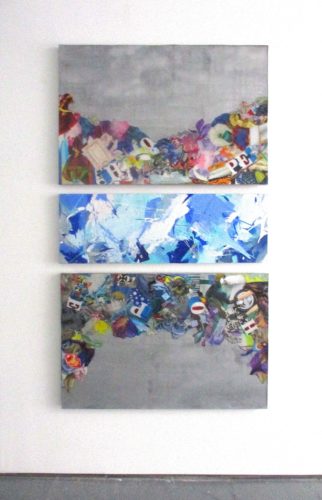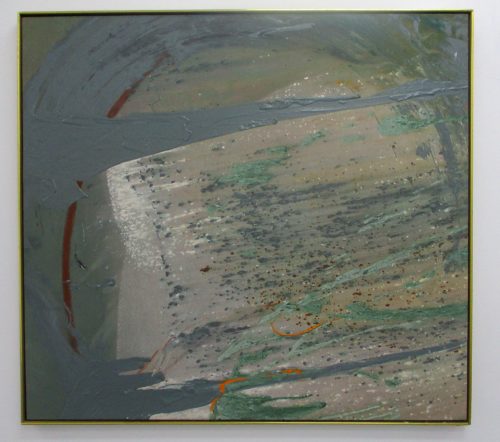ARTIST TALK (also addressing climate change): FRIDAY, JANUARY 10, 2020 from 6:30 – 8:30 PM
Curated by gallery director Priska Juschka, “Remember When It Winter Was” is a collection of works by seven artists (five women and two men), whose colors and imagery demonstrate the influence of wintry visuals in ways that remind us, sadly and increasingly, of the past, so warm have our winters currently become. As might be expected, the artists’ colors tend toward white and blue-white, leading the audience toward hues that might easily suggest snow. Contemporary temperatures have significantly risen, so it can be said that the show itself conveys an elegiac mood, one tempered by the great beauty of the winter season and our unhappy recognition that it is not going to last over the decades. Most of the works are abstract in nature, foregoing a precise reading of winter’s influence on the landscape for something more suggestively non-objective. So color and atmosphere take on a more important part of the show’s attractions, in ways that, hopefully, will speak not only to winters past but winters in the future.
Gretl Bauer’s White Forest (undated) is a beautiful work with what looks like a part of a tree, a slap of textured white, painted bark, made to resemble a white birch trunk, established in the center of the paper behind it. Beyond the trunk, we see what looks like a series of sketched slim vertical trunks, which are in fact cut strips of white paper taken from the edges of spiral notebook sheets. These strips, en masse, are intended to evoke the image of vertical trunks in a forest; they surround the object of the tree in ways that suggest a stand of trees in winter. Somehow a sense of the cold is fostered; maybe it stems from the whiteness of the tree and composition. Artist Jung Ho Lee’s abstraction, Untitled (Beta) (2019) is a more muted piece of work, but winter-like nonetheless in its abstract elements: bars of variegated white laid on top of a blue-gray background, with a few drops and drips of white on the surface. The question becomes, How does abstraction relay a sense of the winter season? In Lee’s work, the feeling of snow arises in the dots and areas of white against the blue-gray. It is an atmosphere more than it is an actuality, although in this case the ambience of the painting suggests a freezing atmosphere, almost to the point where it could be felt as an object.
Pink Horizon (2019) by Vian Borchert is much more clearly a landscape. On the left side, we see a glass blue and white diagonal area, separated from a white blue strip by a black stripe. On the upper half of the diagonal, there is a series of roughly painted blue and whites, which leads upward, to a dark gray and pink horizon painted on a horizontal bar. This is a composition that leans in the direction of abstraction, but the sense of a place is very much clear. The colors do lend themselves to the feeling that we are in the midst of a winter wonderland, but the painting’s raw manner and its inchoate forms emphasizes the act of painting as much as it does an actual place. Olga Ozerskaya’s triptych, called Hope (2019), has a narrow middle panel of a painted blue-white abstraction. The painting of wintry colors is sandwiched in between two predominantly gray panels, with digitally processed heaps of collaged images, to be understood as symbols of our current pop and advertising culture. They occur under a thick, translucent surface on wood and depict a scattered heap of junk-like materials bracketing the central panel. The heap of small, collaged shapes above and below the middle panel, of various colors with some letters of the alphabet, might be the detritus of civilization hemming nature in. It is difficult to say what the symbolism of the painting might be, but the central section is painted with exquisite beauty–as if nature were an absolute against which culture must be judged. This may, or may not, be a false opposition, although it is inspiring to imagine the climate as a piece of high lyricism encompassing cultural existence.
Sallie Strand’s beautiful, coloristically cold abstraction, called Cold Shoulder (2019) is a painting of medium size, mostly with hues of white but with elements of an icy blue in the upper right of the work. The dispersal of paint is a bit messy, with overlaps and impasto. It demonstrates a belief in winter’s inherent beauty, the colors of ice and snow and atmosphere tinted with cold weather. One can only hope that the kind of view of the season will remain realistically genuine and not imagined! Strand paints marvelously well here, paying attention to the whites and colors allied to white that result in a work that feels like a picture of ice about to break. The witty title might well call our attention to worldly matters of affection, but the painting is so abstract, and suggestively in tune with nature, that feel forced to see it as a reading of the outdoors rather than commenting on rejected affection. Looking Glass (1984), a painting by Francine Tint, offers a roughly rectangular white and sand-colored space covered with white and green-grayish spots, with a dark green/gray/brown band swirling around the mirror-like center. The image is aligned with winter hues but otherwise does not communicate an actual representation of cold weather. To the credit of curator Juschka, this work fits in with other, more obvious renditions of her chosen theme. Like many of the works, Looking Glass is posed somewhere between reality and abstraction.
Martin Weinstein’s painting Terrace and Winter, 4 Years (2015-19) consists of a few layers of Plexiglass arranged so that the viewer looks at them as if regarding a single scene. It is a true scenario of winter at twilight, rendered during the course of four winters, with bushes and lengths of stone covered with snow in the foreground, a luminous silver Hudson River in the middle ground, and beyond, a set of hills and clouds, both of them reflecting the late light of an afternoon nearing darkness. Romantic, but not overly so, the painting doesn’t so much mean as be. Weinstein has a home an hour or so north of New York City, and this work demonstrates his view of the landscape there. It is likely the most representational work in this show’s spectrum, offering the audience a chance to see winter as it might have been a couple of generations ago (even if the date of its making is very recent). As I write, we are within a week of Christmas, and so the show is meant to accompany seasonal festivities. We can only hope that the weather as we know it will remain similar to our memory, and that we can appreciate non-objective points of view for winter themes, just as we identify with the limited amount of realism that occurs in the show (which may seem out of date because off climate change). Whatever our feelings about winter’s current state, the artists in the show have done very well in communicating its beauty and lyric state.


